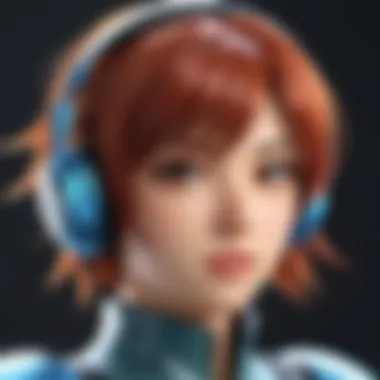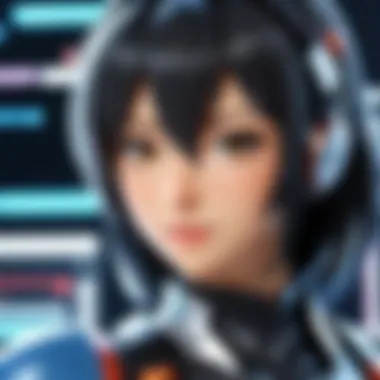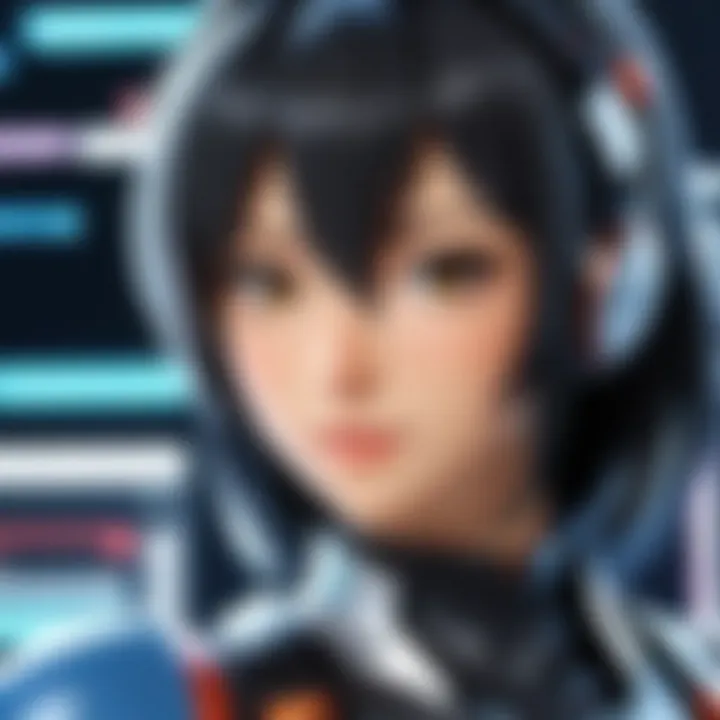Exploring Anime 3D Animation Software: Comprehensive Insights


Intro
The landscape of anime production has evolved significantly over the years. 3D animation software plays a crucial role in this transformation, providing creators with innovative tools to bring their visions to life. As anime becomes more popular worldwide, understanding the software options available is essential not just for industry professionals but also for enthusiasts and students interested in this vibrant field.
In this article, we will explore the various facets of anime 3D animation software. We will analyze different software types, their intended purposes, and typical use cases. Key features and capabilities will be addressed, enabling readers to make informed decisions based on their requirements. Furthermore, an in-depth review of performance metrics and user experience will illustrate how these tools function in real-world applications. This comprehensive guide aims to spotlight standout products while considering emerging trends, ultimately equipping readers with the knowledge necessary to navigate this dynamic software landscape.
Overview of Software
Purpose and Use Cases
Anime 3D animation software serves multiple objectives and fits a variety of use cases. These software solutions can be leveraged in various stages of anime production, from initial concept design to final rendering. Here are some common scenarios where such software is applicable:
- Character Design: Artists can create intricate models that bring characters to life, paying meticulous attention to detail.
- Environment Creation: Settings in which the characters reside can be developed, from serene landscapes to bustling cityscapes.
- Animation: Software allows users to animate characters, applying movement and life to their creations.
- Rendering: Final touches are applied to the scenes before they are exported for viewing or distribution.
This adaptability makes 3D animation software indispensable across different segments of the animation industry.
Key Features
When selecting the right 3D animation software, certain features stand out as critical for efficient workflow and output quality. Here are a few factors that should be taken into account:
- Modeling Tools: These tools allow the creation of complex geometry with precision.
- Animation Functions: Essential features include rigging and skinning possibilities that enable lifelike character movements.
- Rendering Capabilities: The software must provide options for both real-time and high-quality rendering.
- Interface Design: A user-friendly interface ensures that both novices and experts can navigate the software with ease.
- Community and Support: Having access to a robust community and reliable support can greatly enhance the user experience, especially for those just starting out.
Prelims to Anime 3D Animation Software
Anime 3D animation software has become a crucial component in the animation industry. As anime continues to gain global popularity, the need for advanced tools that can create high-quality 3D animations is more pertinent than ever. This segment aims to illustrate why understanding these software solutions is essential for creators, whether they are professionals or hobbyists.
The initial appeal of anime lies in its unique art style and storytelling. However, the integration of 3D animation techniques allows for more dynamic visual experiences. Audiences expect a blend of traditional two-dimensional artistry and modern three-dimensional depth. This blend enhances not only the aesthetic quality but also the storytelling capabilities of anime production.
Several specific elements highlight the importance of 3D animation software in anime production:
- Enhanced Visuals: Three-dimensional graphics provide depth, which enhances the realism and immersion of the audience experience.
- Efficient Workflow: Many software options include features that streamline the animation process. This helps animators to turn ideas into reality faster and with less manual labor.
- Integration of Tools: Advanced software often consolidates various functions—modeling, texturing, rigging, and rendering—into one platform. This reduces the need for multiple applications, which can complicate the creative process.
When considering 3D animation software, one must weigh certain benefits and considerations. First, the learning curve varies by software. Some programs are more user-friendly for beginners, while others cater to experienced animators with complex features. A balance between usability and capability is essential. Furthermore, the cost of software can affect one's decision; investing in reliable software can yield high returns in terms of quality and efficiency.
"The choice of animation software can significantly influence both the creative process and the final product’s quality. Therefore, thorough research and evaluation are essential."
The Evolution of Animation Techniques
The evolution of animation techniques plays a crucial role in understanding how anime 3D animation software has developed and improved over the years. It reveals how the industry has transitioned from traditional methods to digital processes and eventually embraces advanced 3D technology. This evolution not only showcases the technological advancements but also highlights the changing landscape of viewer expectations and market demands.
Traditional Animation Approaches
Traditional animation methods have laid the groundwork for modern practices. Historically, animators relied on hand-drawn frames, which demanded immense skill and time. Each frame had to be meticulously crafted, leading to long production times. However, this method allowed for a unique style, as artists could infuse personal touches into their work.
The beauty of traditional techniques is evident in classics like Astro Boy and Akira. These productions shaped the future of anime and demonstrated the potential of animated storytelling. Still, the demand for faster production times and higher quality content revolutionized the industry, making way for digital solutions.
Transition to Digital Tools
The shift from traditional to digital was both transformative and necessary. Digital tools offered a more efficient way to create animations while retaining artistic integrity. Software such as Toon Boom Harmony allowed animators to combine traditional artistry with new technology. These tools enabled them to streamline their workflows, making tasks like coloring and editing more efficient.
Moreover, this transition democratized animation. Independent creators gained access to software that previously required significant investment. Today, even novice animators can start their journey with user-friendly programs, further expanding the range of voices and stories in the anime industry.
Advancements in 3D Technology
The most significant leap forward came with the rise of 3D animation technology. Software like Autodesk Maya and Blender brought new dimensions to anime production. This shift allowed for more dynamic visual storytelling and the creation of immersive worlds.
3D capabilities enable artists to manipulate characters and scenes in ways that were impossible with traditional methods. Today, viewers enjoy complex action sequences and detailed backgrounds that enhance their experience. The integration of advanced features, such as physics simulations and character rigging, marks the pinnacle of what anime production can achieve.
Key Features of 3D Animation Software
The selection of an appropriate 3D animation software is crucial for anyone working in the field of animation. Each software offers unique features that can significantly affect the workflow and final output of the project. Understanding these key features can aid users in identifying which tools best suit their specific needs. Here, we examine several core aspects of 3D animation software, including modeling tools, animation capabilities, rendering options, texturing and materials, and user interface.
Modeling Tools


Modeling is often the first step in the animation process. Quality modeling tools enable users to create detailed three-dimensional objects. The options often include polygonal modeling, sculpting features, and parametric design. Effective modeling directly influences the quality of the animations produced. Software like Blender and Maya provide various modeling functionalities that cater to different skill levels and project requirements. Having intuitive tools can foster creativity, allowing artists to realize their vision without hindrance. However, understanding the complexity of these tools can require a steep learning curve, particularly for beginners.
Animation Capabilities
Animation capabilities encompass the range of functions that a software offers for creating motion. Key features include rigging, skinning, and keyframe animation. Rigging involves setting up a ‘skeleton’ for models, which is crucial for movement. Advanced software solutions often provide features that support motion capture and procedural animations. Being adept at these functions can enhance the productivity and efficiency of animators, providing them the flexibility to experiment with animated sequences. Beginners should look for software that offers tutorials and community support.
Rendering Options
Rendering is the process that converts a 3D model into a 2D image. This stage is crucial, as it impacts the overall quality of the final product. Various rendering engines like Arnold and V-Ray offer different techniques, such as ray tracing or rasterization. A comprehensive rendering option must support real-time rendering for quicker feedback during the creation process. Understanding the trade-offs between quality and speed can be paramount for animators, especially in a production environment where deadlines are strict. Additionally, hardware compatibility should be considered since rendering can be resource-intensive.
Texturing and Materials
Texturing involves applying images to 3D models to give them a realistic appearance. This includes creating materials that mimic real-world surfaces, like metal, wood, or skin. The ability to create complex textures directly affects the visual richness of the animation. Software that integrates advanced texturing tools, such as Substance Painter, allows for procedural texturing and layering, which can produce high-quality results. The importance of this feature lies in its impact on viewer perception, making it all the more significant in storytelling.
User Interface and Experience
The user interface (UI) is the gateway to software functionality. A well-designed interface should enhance workflow and minimize distractions. The learning curve associated with the UI can vary widely among different software; hence, ease of use is a critical consideration. User experience should focus not only on the visual layout but also on the accessibility of tools and intuitive design. For new users, a clear and responsive UI can significantly impact their ability to grasp complex concepts quickly and effectively. Software with community-driven tutorials can also provide valuable assistance during initial use.
"A negative user experience can frustrate users, detracting from their creative workflow."
Overall, recognizing the key features of 3D animation software allows artists and developers to make informed decisions. A robust understanding of these elements ensures that the chosen software aligns with artistic goals and project requirements.
Popular Anime 3D Animation Software
The world of anime 3D animation software is vast and varied. Choosing the right software is crucial for both professionals and enthusiasts. Each software offers unique features and tools that cater to different styles of animation. Understanding the options available can help users create stunning visuals and streamline their workflows.
Maya
Maya stands out in the realm of 3D animation software. Developed by Autodesk, it is known for its robust modeling and animation capabilities. Many studios use Maya for film and game development due to its advanced tools for character rigging and simulation. One major feature is its Bifrost system which facilitates real-time dynamics and visual effects. This allows animation artists to create more realistic scenarios without excessive render times.
Many professionals consider Maya to be an industry standard, but its learning curve can be steep for beginners. However, countless resources are available online, like tutorials and forums, which can ease the learning process.
Blender
Blender has gained a strong reputation as a free and open-source alternative to paid software. Its community-driven nature contributes to a variety of plugins and features. Blender includes comprehensive tools for sculpting, UV mapping, and rigging. This flexibility makes it suitable for amateur creators to professional studios.
One distinct advantage of Blender is its constant updates. The developers regularly introduce new features based on user feedback. This ensures that users have access to the latest trends in technology and animation within the software.
Cinema 4D
Cinema 4D, developed by Maxon, is well-regarded for its motion graphics capabilities. Its intuitive interface allows users to model, animate, and render quickly. The software excels in integrating with Adobe products, particularly After Effects. This feature makes it a favored choice for animators who work on project that requires seamless transitions between 3D elements and video.
Users often appreciate the quick workflow and customizable options available in Cinema 4D. However, it tends to focus more on motion graphics rather than complete 3D character animation, which is an important consideration based on project needs.
3ds Max
Autodesk's 3ds Max is another strong contender in the 3D animation software landscape. It is particularly favored in architectural visualization and game development. The software includes powerful modeling tools and detailed material systems. Its compatibility with a range of engines enhances its appeal to developers.
One benefit of 3ds Max is the extensive library of plugins available. Users can expand functionality to suit their specific needs. The user community is active, providing resources to aid new users.
Krita
Krita, while primarily known as a digital painting tool, has features that make it useful for 3D animation as well. It provides functionalities for animators focused on 2D animation but integrates well with 3D modeling processes. Krita boasts an intuitive UI, making it a viable option for artists transitioning from traditional to digital formats.
While Krita may not match the advanced features of complete 3D software, it offers a unique approach for specific projects, especially when blending 2D and 3D elements. Users should consider their animation style when evaluating its capabilities.
"Selecting the right anime 3D animation software is pivotal for achieving desired animation outcomes. Each software offers distinctive tools and capabilities that can influence the final product."
In summary, these popular software options each have strong points that cater to diverse animation needs and styles. Taking into account the feature sets, user experience, and project requirements will lead to more informed choices in software selection.
Comparative Analysis of Software Options
The comparative analysis of software options is crucial in this article, highlighting the multifaceted nature of 3D animation software used in anime production. By understanding distinctive features, strengths, and limitations of various software, users can make informed decisions tailored to their unique needs. Each option presents different interfaces, tools, and capabilities. This analysis plays a significant role for both professional developers and students aiming to learn the intricacies of the software industry.
When examining software, performance metrics, cost-effectiveness, and community support emerge as critical elements that potential users should consider. These aspects serve to inform choices and ultimately enhance the quality of animation projects.


Performance Metrics
Performance metrics encompass various parameters that determine the effectiveness of 3D animation software. Key indicators include rendering speed, stability, and responsiveness during the animation creation process. Users often prioritize how efficiently software can handle complex scenes without crashing or slowing down.
- Rendering Speed: A good animation tool should minimize the time taken to render high-quality outputs. Different applications may have specific optimizations that enhance this aspect, tremendously impacting workflows.
- Stability: Software must be reliable. Frequent crashes can halt productivity and frustrate creators, especially when facing tight deadlines.
- Responsiveness: The user interface should allow for smooth interaction. Lag in response times can disrupt creativity and cause workflow interruptions.
Understanding these metrics helps users evaluate options against their expected project scales and specific animation requirements.
Cost-Effectiveness
Cost-effectiveness extends beyond just the initial price of the software. A thorough analysis must take into account additional factors such as maintenance costs, available features, and potential return on investment. Several fundamental questions arise when navigating this area.
- License Types: Some software may require ongoing subscriptions, while others offer one-time purchases. Analyzing long-term investment can reveal which option provides more value for users.
- Feature Sets: Consider whether the software provides advanced features in lower-tier packages or bundles. Evaluating these can highlight software that delivers the best overall performance for the cost.
- Training Resources: Ease of learning due to available resources can influence overall cost-effectiveness. If steep learning curves result in extended training times, the initial savings may not justify the long term.
Thus, scrutinizing cost alongside performance ensures users do not overspend for ineffective solutions.
Community Support and Resources
Strong community support is fundamental as it fosters a collaborative environment. Effective community resources such as forums or online guides enhance the user experience. A robust community can offer assistance that helps mitigate issues when learning or using the software.
- Forums and Discussion Boards: Platforms such as Reddit host discussions, enabling users to share experiences and solve common problems.
- Tutorials and Workshops: Availability of tutorials provides necessary knowledge for both beginners and advanced users. Sites such as YouTube or Skillshare often have extensive content that can accelerate learning.
- Updates and Bug Fixes: Active development by software firms often signals robust community reception. Regular updates indicate ongoing improvements, significant for maintaining efficiencies in animation projects as trends evolve.
Industry Applications of 3D Animation Software
3D animation software plays a crucial role in several industries. Its applications stretch beyond entertainment, impacting sectors such as gaming, education, and emerging technologies like virtual and augmented reality. Understanding these applications helps individuals and organizations appreciate the software's versatility and its significance in the modern digital landscape. This section will explore these applications in detail, highlighting the specific benefits and considerations of each industry.
Film and Television Production
In film and television, 3D animation software is vital for creating captivating visuals and engaging stories. Maya, Blender, and other software tools enable artists to craft intricate characters and backgrounds. These tools facilitate a blend of live-action and computer-generated imagery, enhancing the storytelling experience.
Some benefits include:
- Visual Effects: Software allows for dynamic visual effects which would be difficult or impossible to achieve practically.
- Cost-Effective Solutions: Using 3D software can reduce production costs, especially for complicated scenes that require extensive sets or special effects.
- Time Efficiency: 3D animation speeds up production by allowing artists to quickly generate options for scenes and characters.
Considerations include the learning curve associated with various software and the necessity of skilled animators to achieve high-quality results. Attention to detail is crucial, as it can make or break the viewer's experience.
Game Development
The gaming industry heavily utilizes 3D animation software to create immersive environments and realistic characters. Tools like 3ds Max and Unity integrate animation features that allow developers to simulate physics and interactions seamlessly.
Advantages of 3D animation in gaming include:
- Realism: Enhanced graphics bring characters and worlds to life, increasing player engagement.
- Interactivity: Developers can create responsive environments that change based on player actions, enhancing gameplay depth.
- Cross-Platform Capabilities: Animations created can often be utilized across different gaming platforms, making development processes more efficient.
However, game developers must also manage hardware limitations and performance issues. Optimizing models and animations for various platforms is an ongoing challenge.
Education and Training
3D animation software serves an important educational purpose by providing visualizations that enhance learning. This is especially true in fields like biology, engineering, and architecture, where complex concepts benefit from visual representation.
Reasons for its use in education include:
- Enhanced Understanding: Visual aids help students grasp challenging concepts more easily.
- Engagement: Incorporating 3D animations in teaching materials can increase student interest and participation.
- Practical Applications: Students can create their own animations to demonstrate understanding, encouraging creativity and critical thinking.
The challenge lies in access to resources and training for educators to effectively implement these tools in their curriculum.
Virtual Reality and Augmented Reality
3D animation software is foundational in the realms of virtual reality (VR) and augmented reality (AR). Creating immersive experiences requires sophisticated animation techniques to ensure realism and interactivity.
Key elements of these applications include:
- Immersive Experiences: Both VR and AR rely on high-quality animation to transport users into different environments and scenarios.
- Interactivity: Users can engage with their virtual surroundings, making 3D animation critical for effective design.
- Innovative Solutions: Industries like healthcare, retail, and real estate are leveraging VR and AR for training, marketing, and simulations.


However, there are significant considerations regarding hardware requirements and the ability of target audiences to access these technologies.
Overall, 3D animation software is more than a tool for creative expression. Its industry applications showcase its potential to reshape how we experience narrative, education, and interactive environments.
Current Trends in 3D Animation Software
The landscape of 3D animation software is ever-evolving, and current trends have a significant impact on how animators and developers approach their craft. Understanding these trends is critical for those in the industry. They not only indicate the direction of software development but also highlight the advancements that enhance creativity and efficiency.
Integration with AI Technologies
Artificial intelligence is changing how animation is created. By incorporating AI technologies, software can automate tedious tasks and provide smarter tools for animators. For example, motion capture systems can be enhanced to analyze movements and suggest optimal animations based on learned patterns. Furthermore, AI can assist in rigging and skinning processes, which typically require extensive manual work. This integration reduces the time spent on routine tasks, allowing animators to focus on the artistic aspects of their projects.
Cloud-Based Solutions
Cloud computing is another important trend. Cloud-based solutions enable collaborative work environments, where animators can access projects from anywhere and share large files without the limitations of local storage. Software like Autodesk Maya and Blender offer cloud functionalities that facilitate teamwork. This approach promotes flexibility and scalability, making it easier for companies to manage resources. However, it is also essential to address concerns about data security and software accessibility in such environments.
Open-Source Alternatives
Open-source software is gaining traction as a viable alternative. Programs like Blender provide powerful tools without the high costs associated with proprietary software. These platforms encourage community contributions, allowing users to modify and enhance the software based on specific needs. The open-source model democratizes access to quality tools, empowering more artists and developers to explore 3D animation. Such options are particularly appealing for freelance animators and small studios with limited budgets.
"Open-source alternatives empower artists by providing advanced tools without financial strain."
In summary, current trends in 3D animation software, including AI integration, cloud-based solutions, and open-source options, are pivotal for shaping the future of animation. Staying informed about these developments helps professionals and students make better decisions regarding the tools they choose to utilize.
Considerations for Choosing Software
Selecting anime 3D animation software requires a careful evaluation of several factors. The right choice significantly impacts the quality of the final product and the efficiency of the production process. Each software offers unique features and capabilities, and understanding these can lead to better artistic expression and technical execution. This section discusses critical elements that should guide the decision-making process in selecting suitable software for 3D animation.
Skill Level and Experience
The skill level of the user plays a pivotal role in software selection. Beginners might prioritize user-friendly interfaces and extensive tutorials. Software like Blender provides a robust community and plentiful resources for learning. For professionals, advanced functionalities and fine control are essential. They may opt for Maya or 3ds Max, both of which offer intricate tools for detailed animation work.
Users must also consider their experience with similar software. Transitioning smoothly may require familiarity with certain tools or interfaces. If one has used traditional animation tools, finding software that eases that transition is necessary.
Project Requirements
Project specifications greatly influence software choice. Not all programs are suited for every task. For instance, someone focused on game development might lean towards Unity or Unreal Engine for better integration with game design features. On the other hand, if an artist's goal is to create a short film, options like Cinema 4D or Blender might be more appropriate due to their powerful rendering capabilities.
Moreover, understanding whether the project requires real-time rendering or high-quality outputs is vital. This decision affects not only the choice of software but also the hardware needed to run it efficiently. Choosing software aligned with project needs ensures that creators maximize their productivity without unnecessary complications.
Budget Constraints
Financial limitations are another key consideration. Some software options are commercial and can be costly, while others, like Blender or Krita, are open-source and free. When budget is a factor, evaluating the available features against cost is crucial.
The pricing structure may vary significantly based on licensing options. Monthly subscriptions, one-time purchases, or usage-based fees can impact long-term financial planning. Moreover, free alternatives should be assessed critically; while they save money, they might lack certain professional features found in paid versions.
"Choosing the right software is not just about personal preference; it's about aligning tools with artistic vision and technical requirements."
Overall, careful consideration of skill level, project specifications, and budget constraints will help users identify the software best suited to their animation needs, providing a strategic advantage in their creative endeavors.
Future Directions of Anime 3D Animation Software
The future directions of anime 3D animation software is vital for understanding how technologies will evolve, impacting both creators and viewers. As technology progresses, so does the capability of software to meet the demands of industry professionals and casual users. This section will cover anticipated advancements and market trends that are shaping the landscape of animation software.
Anticipated Technological Advancements
One area that is expected to see significant growth is the integration of artificial intelligence (AI) within animation software. AI promises to streamline various processes, from character rigging to animation creation. Machine learning algorithms can learn from existing animations and suggest enhancements or create realistic movements autonomously. Through these advancements, animators can focus more on creativity while leaving repetitive tasks to the software.
Further, the shift toward real-time rendering is notable. Applications like Unreal Engine are paving the way for real-time content creation, reducing the time from concept to final product. This is crucial for industries that require rapid turnaround, such as gaming and live events.
In addition, the user experience (UX) will see enhancements as developers prioritize intuitive interfaces. As 3D animation becomes more prevalent, ensuring that software is accessible to a broader audience is essential. Improved UX means even novice users can create professional-quality animations.
Emerging Market Trends
The anime 3D animation software market is witnessing several trends that are shaping its future direction. One such trend is the growing popularity of cloud-based solutions. With cloud software, users can access powerful tools without needing high-end hardware. This opens opportunities for creators in developing regions where access to expensive equipment is limited.
Moreover, the rise of collaborative platforms allows teams to work on projects concurrently. This trend is especially relevant in remote work environments, fostering creativity and efficiency.
Additionally, there is an increasing interest in animation education, which calls for software companies to provide educational versions. These versions often come at a reduced cost or with additional training materials, making them more attractive for students and newcomers to the field.
"The evolution of software solutions in animation is a direct response to the needs of creators and the market perception, which shapes how we can express ideas visually."







